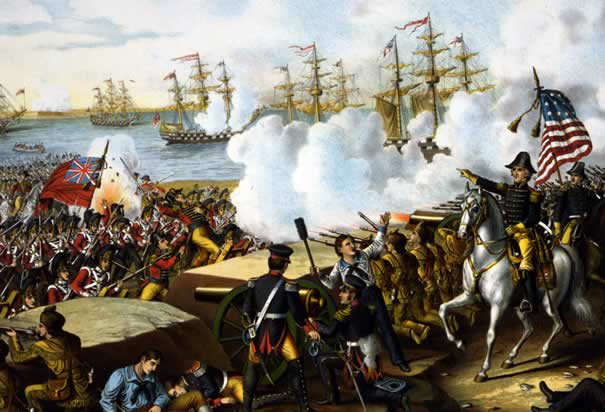
The following article by David Strange was originally published on 8 Nov 2015. It is archived here for your reading enjoyment.
The War of 1812 is often called the second Revolutionary War.
Judy Richardson, a longtime volunteer at the Bullitt County History Museum, recently completed over two years of research on the war with an emphasis on its connections to Bullitt County. The result is two three-inch thick binders of information.
Not intended as a book or as a definitive work on the war itself, Judy's goal was to connect with the men who fought this war who were also connected in some way to Bullitt County. Her research covers fourteen militia companies and over 800 men. One volume gives general information on the war, links to many other research sources, and information on the militia companies of John Hornbeck, Frederick W. S. Grayson, and Jacob Peacock. The second volume gives information on the militia companies of Thomas Joyes (Joyce), John Farmer, Leonard Higdon, James Hite, Samuel Kelly, Joseph McCloskey, Thomas Speed, Martin Wickliffe, John Miller, Zachariah Terrill, and Robert Barnett.
The work includes a number of biographies, including a copy of the extensive diary of Jacob Peacock. Unpublished, Judy's work is currently available only as a research aid at the Bullitt County History Museum research room. The museum is located in the Bullitt County courthouse and is open whenever the courthouse is open.

You might have seen the recent PBS TV presentation about the war. It was excellent. A famous trivia point about the war is that the Battle of New Orleans, a big victory for Americans, was actually fought after the peace treaty had already been signed. Because of slow communications of the time from Europe, most Americans did not learn of the Treaty of Ghent (signed December 24, 1814) until after hearing of the American victory at New Orleans (January 8, 1815). So in the popular mind, the treaty was caused by the victory at New Orleans, which led in very large part to the presidential election victory of Andrew Jackson. The war is measured by most scholars as a draw, but America did hold its own against a powerful foe. Judy Richardson comments about the Battle of New Orleans, "Sure the war was already over. But they didn't know that, and more importantly the enemy was still coming at them."
Twelve hundred Kentuckians died in the War of 1812; more than any other state. Only one Bullitt Countian (Jacob Hardy, in a hospital in New Orleans) is known to have died.
Soldiers in the War of 1812 are quite difficult to document. Most of the "soldiers" were really militia; regular citizens like you and I who volunteered for just 60-90 days to help out and then expected to go back home. Individual members of a company were constantly flowing in and out of service. Sometimes all would go home, but later re-muster with perhaps the same officers but a different group of men. Judy's work includes many different aspects of connection, including birth, marriage, etc.
Judy says she learned so much during her research. For example, she gained a better understanding about what was going on in Kentucky, America, and the world at that time. Charles Wickliffe of Nelson County joined the war as a private, but eventually became governor of Kentucky. She learned about Edward Hessy who is buried in Mt. Washington.
Judy learned the amazing connections that the people had by family and acquaintance, and about the local Robards family connection to Andrew Jackson. She learned of Moses Hogland (Hoagland) who was fishing with his father near Pitts Point when Indians ambushed them, killing the father and taking him hostage. After twelve years, Moses was released in 1795, and became a renowned Indian fighter in the War of 1812. Judy had heard about such things, but doing the research allowed her to see it up close and personal. Judy says she remains impressed with how settler families came to Kentucky often with nothing more than maybe a horse and a gun. "Those must have been some hardy folks."
Judy's previous work includes research on TV and movie star Gardner McKay (who is buried in Bullitt County), and general visitor support at the Bullitt County History Museum. She has been working with other museum volunteers for years to document Bullitt Countians who have died while in service in all wars. She started with the current wars and has been working back into history.
Judy says about the War of 1812, "There are many stories to be told about these brave men. Our nation was in its infancy and Kentucky was barely settled. Yet even after the families endured the hardships of traveling to this wild place, establishing a home, struggling with the everyday challenges of living in the wilderness, these men left their wives and children to fight yet again for the right to keep what they had achieved. Times had to be hard for all."
Copyright 2015 by David Strange, Shepherdsville KY. All rights are reserved. No part of the content of this page may be included in any format in any place without the written permission of the copyright holder.
The Bullitt County History Museum, a service of the Bullitt County Genealogical Society, is located in the county courthouse at 300 South Buckman Street (Highway 61) in Shepherdsville, Kentucky. The museum, along with its research room, is open 10 a.m. to 4 p.m. Monday through Friday. Saturday appointments are available by calling 502-921-0161 during our regular weekday hours. Admission is free. The museum, as part of the Bullitt County Genealogical Society, is a 501(c)3 tax exempt organization and is classified as a 509(a)2 public charity. Contributions and bequests are deductible under section 2055, 2106, or 2522 of the Internal Revenue Code. Page last modified: 12 Sep 2024 . Page URL: bullittcountyhistory.org/memories/war1812.html